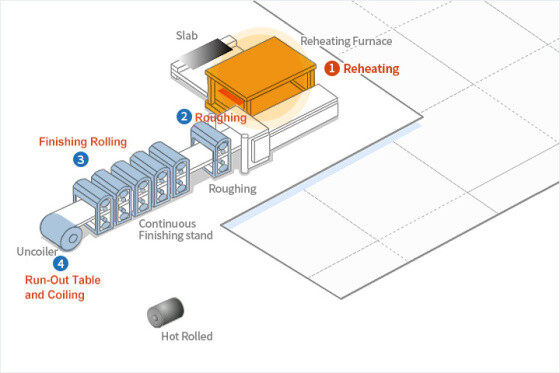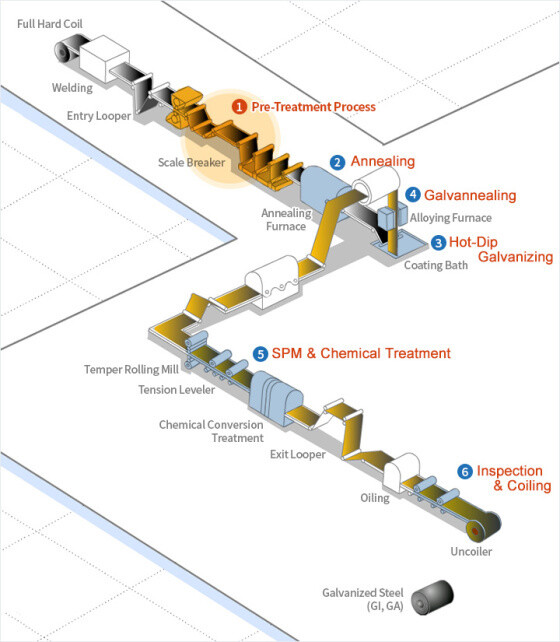 Hot Rolled Steel
Hot Rolled Steel1. Reheating: Hot rolled coils pass through a pickling line, where scale breaker machines and hydrochloric acid solutions are used to remove any surface scale and/or oxide film that which causes surface flaws during the final stage of cold rolled steel processing.
2. Roughing: In this process, slabs whose surface scale share has been removed are made into rolled materials with the proper shape, thickness, and width. In the entry and exit area of the roughing mill, an edger rolls the strip in the width direction using an Automatic Width Control (AWC) system.
3. Finishing Rolling: The purpose of finishing rolling is to adjust the thickness and width of a coil to the specified dimensions and to produce a smooth surface and shape at the desired finishing temperature appropriate for its intended use. Our up-to-date equipment, including Work Roll Shift Mills, Pair Cross Mills and On-line Roll Grinders (ORG), enhances plant productivity and improves the quality of the finished coils by controlling the crown shape.
4. Run-Out Table and Coiling: Steel strips, after the finishing mill, are passed to the run-out table where they are coiled. While being rolled on the table, the strips are sprayed with water to cool them to the proper temperature for coiling.More Content Electrical steel
Electrical steel1. Preliminary Annealing: During the preliminary annealing process, a scale which may have formed on the hot rolled steel is removed as delayed passing through scale breaker and a hydrochloric acid bath. This initial heat treatment process improves the cold rolling properties of steel as well as its magnetic properties.
2. Cold Rolling: In order to obtain specific thickness and material properties, a reduction ratio of 40-90% is applied normally. Rolling and edge trimming machines are automatically controlled to obtain uniform thickness and width.
3. Annealing: Annealing is a process in which cold rolled structures are converted to a recrystallized structure through heat treatment. For grain oriented electrical steel, two different annealing methods are available: decarbonization annealing and high-temperature annealing. Decarbonization annealing removes excess carbon from the steel and applies a MgO coating. High-temperature annealing produces secondary recrystallized structures having superior magnetic properties.
4. Insulation Coating: In this process, insulation coating is applied by a continuous coater roll in order to minimize eddy current losses, which are proportional to the sheet thickness. A series of coaters are used to apply insulation coating liquid to the top and bottom of a plate. Grain oriented electrical steel has two layers of coating, a base coating of dark brown Forsterite (Mg2SiO4) as the main ingredient and a transparent insulating coating containing phosphates. For non-oriented electrical steel, various coating methods with various thicknesses and ingredients are used depending on end usage and specific user’s requirements.More Content Cold Rolled Steel
Cold Rolled Steel1. Pickling: Hot rolled coils pass through a pickling line, where scale breaker machines and hydrochloric acid solutions are used to remove any surface scale and/or oxide film that which causes surface flaws during the final stage of cold rolled steel processing.
2. Cold Rolling: Pickled coils are cold rolled in tandem mills to a specified thickness, typically 40 to 90%, of original material dimensions. Fully automated shape adjustment is ensured through state of the art process machinery.
3. Electrolytic Cleaning: The purpose of electrolytic cleaning is to remove lubricant oil and contaminants on the cold rolled steel prior to the annealing process.
4. Annealing: This is a highly productive manufacturing method whereby steel products with extra deep drawing qualities and high tensile strength can be produced. Two annealing methods are commonly used: batch annealing and continuous annealing.
5. Skin Pass: This final rolling process is performed in order to remove minor surface defects such as stretch marks and to produce a smooth, lustrous surface. Skin Pass results in a further thickness reduction of about 1%.More Content Galvanized Steel
Galvanized Steel1. Pre-Treatment Process: Some rolling oil and other contaminants remain on the surface of cold rolled steel sheets following processing. These are removed by passing the electrically charged sheet through an alkaline solution which induces an electrochemical reaction.
2. Annealing: The material properties of the pre-treated steel sheet can be altered and improved through recrystallization during the annealing process.
3. Hot-Dip Galvanizing: After passing through the annealing furnace, steel sheets are dipped into a zinc pot where molten Zn is coated onto the surface. The desired coating weight is achieved by removing excess zinc before solidification with high-pressure air from an air knife.
4. Galvannealing: The surface of a steel sheet, after the air knife, can be coated with a zinc compound prior to reheating in an annealing process. Zn atoms diffuse into the Fe to create a Zn-Fe series alloy.
5. SPM & Chemical Treatment: In order to achieve a flat surface and an elegant finish, the steel sheet is processed with a skin pass mill. In order to prevent the white rust, which often forms on the surface of activated zinc, and to improve corrosion resistance, the surface is coated with a Cr-free resin.
6. lnspection & Coiling: In order to achieve a flat surface and an elegant finish, the steel sheet is processed with a skin pass mill. In order to prevent the white rust, which often forms on the surface of activated zinc, and to improve corrosion resistance, the surface is coated with a Cr-free resin.More Content





